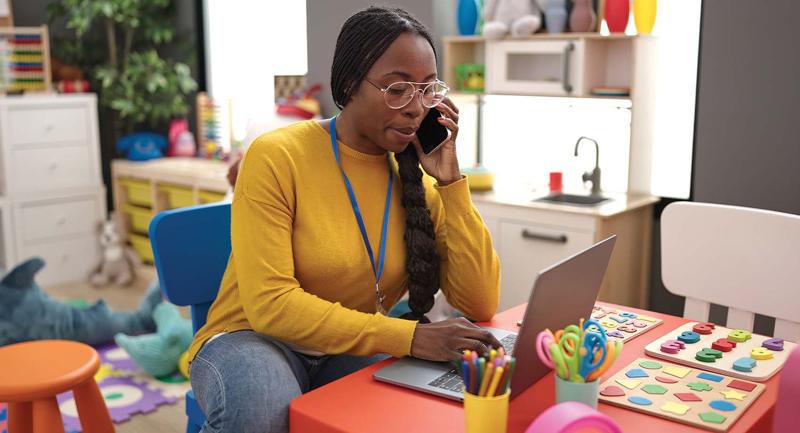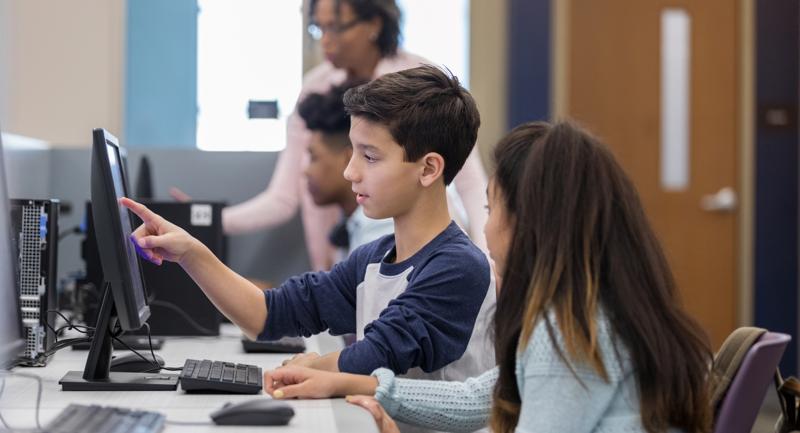Greg Heideman had a scheduling conflict. The principal of Lone Star Middle School in Nampa, Idaho, needed to take a personal day in November 2021, but he had important meetings with two teachers on his calendar. Pre-pandemic, Heideman would have had to shuffle around his commitments to squeeze in the meetings on another day. Instead, he managed to keep his day off but still meet his teachers at the appointed time on Microsoft Teams, the videoconferencing platform that Lone Star uses. The school had had the capability to conduct video meetings before the pandemic but rarely bothered with the technology. That quickly changed when Lone Star, like schools nationwide, pivoted to virtual operations in spring 2020. Now with students and teachers back in the classroom, Heideman can't imagine working without the digital tool at his disposal. "It was learning born out of necessity," he says.
School leaders like Heideman have done a lot of on-the-fly tech learning the past two years. They hosted their first faculty meetings on Zoom—and discovered they needed much more practice setting up the breakout rooms. They recorded their first YouTube video for students, and then recorded it 10 more times because they kept flubbing their lines. They coached and sometimes cajoled tech-averse teachers to create digital classrooms, then watched in awe as those same teachers gained confidence in their new skills and embraced online tools.
As schools swung from fully remote to fully in-person to something in between, principals acquired a clearer perspective on the role that technology can play in their students' success and the effective management of their schools. They saw firsthand the ways in which digital instruction can enhance education as well as the ways in which it remains second-best to in-person pedagogy. What they have learned continues to influence their work today.
Connecting—With Convenience
One lesson has been about the power of virtual venues for important conversations. As Heideman found, communicating with teachers no longer requires being in the same room with them, which means valuable time-saving in the jam-packed schedules of busy principals. But the technology has proved especially beneficial for discussions with parents or other caregivers. A new report by Digital Promise, a nonprofit that works with schools and districts nationwide on the effective use of technology, notes that one unexpected outcome of the shift to virtual learning was an increase in communication between schools and families (Stephenson et al., 2021). When parent conferences and school meetings migrated online, some barriers to participation were removed, according to the report, which was commissioned by The Wallace Foundation and provides considerations for districts seeking to train principals who can lead effectively and equitably in both virtual and physical realms.
Among other advantages, Digital Promise found that technology helped strengthen home-school connections in under-resourced communities. One principal interviewed for the report described an "off the charts" level of family involvement because of the new option of conversing online. "We can now have meetings and invite families in this manner that is comfortable for them and attainable for them," the principal told the authors.
Similarly, family engagement shot up at Malachi Wilkerson Middle School in Birmingham, Alabama, when the school switched to virtual open houses and parent conferences during the pandemic. Working parents could suddenly connect with their child's teacher during their lunch break. A family member with disabilities could join a call from home. Principal Davida Hill-Johnson knew a good thing when she saw it. Today, the Title I school holds its parent meetings both in-person and on Zoom. Including a virtual option removes some of the barriers and "creates more parent involvement," she says.
With the return of in-person learning, principals are evaluating when it makes sense to integrate technology into teaching and learning—and when it does not.
Jennifer Gill
At the same time, principals who can now send news and information home to families with an ease impossible in the days of notice-by-backpack have had to learn how to avoid overloading those on the receiving end. In surveys and calls during the early months of the pandemic, some Lone Star parents complained that the school was blowing up every communication app they had, so much so that they had resorted to blocking emails and turning off notifications. Heideman made adjustments and now sends announcements weekly, instead of daily. He also became more intentional about posting information to the school's website and directing families there, rather than pushing everything out by email.
Trevor Goertzen, principal of Spring Hill Middle School in Spring Hill, Kansas, took a similar approach internally. Based on staff feedback, he ditched weekly emails that often got buried in teachers' inboxes. Instead, he created a common Google site where staff members can access important information on demand. Goertzen updates the site every Friday with upcoming school events, professional development articles, and birthday shout-outs.
Teaching with Tech
Communicating with adults is one thing. Teaching K–12 students is another. After being compelled by the pandemic to roll out virtual instruction, many principals have discovered anew that technology can be invaluable to learning. "Five years ago, if a teacher used Google Classroom or had students turn in an assignment online, it was all extra, rosettes on top of the cake," says Brian McCann, principal of Joseph Case High School in Swansea, Massachusetts. "Now it's expected. [Virtual learning during the pandemic] became a catalyst for teachers to recalibrate their expectations for their own pedagogy."
With the return of in-person learning, principals and teachers are evaluating when it makes sense to integrate technology into instruction—and when it does not. During the pandemic, for example, Goertzen at Spring Hill Middle School approved an online tool suggested by his math teachers that allowed them to create digital formative assessments. The tool made it much easier for them to monitor student learning when school was virtual, but now that everyone is back in the building, the math department uses it much less. The reason? Students, the teachers told Goertzen, really need to tackle math problems with pencil and paper. Goertzen, named the 2021 Digital Principal of the Year by the National Association of Secondary School Principals, follows his faculty's lead. "They're using digital tools more effectively and correctly, when it's appropriate," he says.
Striking this healthy balance between digital learning and old-school ways is top of mind for Allyson Apsey, principal of Quincy Elementary School in Zeeland, Michigan. Pre-pandemic, the school's roughly 500 students often used their iPads as an alternative to whiteboards. Now teachers rely on the devices to differentiate reading assignments in the structured literacy program Lexia, for example, so students are working at a level that's suitable for them. Teachers find it a helpful tool to engage students while they provide small-group instruction or to fill in downtime, such as during morning arrival. That said, notes Apsey, "we still want books in kids' hands. We want them to have legible handwriting. We have to make careful decisions on when it makes good sense to incorporate devices."
Getting to the point of being able to make these thoughtful decisions took some doing. School leaders interviewed for the Digital Promise report described their new responsibilities to help teachers develop as digital educators. They noted, for example, that they are personally evaluating digital content being used in instruction as well as investigating how technology enables differentiated learning. In a spring 2020 survey conducted by Speak Up, a national research project by the education nonprofit Project Tomorrow, only about 28 percent of teachers rated their tech skills as advanced (Project Tomorrow, 2021). During the early period of the pandemic, principals, who are in some cases tech novices too, found themselves modeling digital tools for their faculty and hosting mock Zoom classes to demonstrate the video platform's capabilities.
The abrupt shift to virtual learning in March 2020 raised the importance of having a shared vision for integrating technology in instruction to support student achievement. "Teachers were absolutely driving that conversation," says Stefani Pautz Stephenson, director of educator community partnerships at Digital Promise. "Having been asked to suddenly teach virtually, they wanted to know, 'What does success look like for me as an educator? How do I know if I'm serving my students?'" Indeed, nearly half of teachers, principals, and district leaders polled by EdWeek Research Center in 2021 said that one of the three biggest tech challenges they faced was how to use digital tools to teach effectively (Klein, 2021a). (The other two challenges: Parents lacking tech skills to help their children with online learning and internet connectivity.)
For teachers at Quincy Elementary School, overcoming that challenge came in part through collaboration. Before the 2020–21 school year, Zeeland's public schools gathered all the teachers from its seven elementary schools for several days of intensive curriculum mapping. Anticipating that learning would be a mix of in-person and virtual, educators worked together to share and identify digital materials and tools that they could use to teach concepts in math, reading, and other subjects.
The experience, says Apsey, the Quincy Elementary principal, has increased district-wide collaboration exponentially. Links to videos, websites, and other digital content now populate the school's curriculum maps, making them "so much more robust than they were pre-pandemic, which translates to more cohesiveness in instruction across the district," Apsey notes. "Our teachers really recognized the value of opening their classroom doors to each other." Some of the new digital resources are locally made. Today, Quincy 1st graders are just as likely to know a 1st-grade teacher from across town as their own because they've watched phonics videos that she stars in and shared with her peers.
Reassessing Assessments
Remote learning also meant remote testing, which gave principals an opportunity to ramp up their school's use of timely, digitally captured student performance data to tailor instruction to student needs. In spring 2020, three out of four principals told Speak Up that a rich data set on student performance was an important characteristic of digital content for personalized learning (Project Tomorrow, 2021). While teachers at Birmingham's Wilkerson Middle School had used online assessments occasionally before the pandemic, usage accelerated during virtual learning and continues with students back in-person. "The days of grading 100 quizzes are done," says Hill-Johnson.
We have to be concerned about the ‘techquity’ piece.
With online assessments, Wilkerson teachers get instant feedback on students' understanding of the material and can tweak instruction accordingly. Timely data can hasten other types of intervention too. If a teacher has two 7th grade math classes, for instance, and test data show one class excelling while the other is not, the information can trigger a closer look at classroom dynamics. "We want to know what's interfering with their learning: Is it an attendance issue? A discipline issue?" explains Hill-Johnson.
"Techquity" Issues Exposed
One thing for certain is that digital learning devices have proliferated in schools thanks to district purchases to support remote learning during the height of the pandemic. Nine out of 10 educators polled by EdWeek Research Center in 2021 said there was at least one device for every middle and high school student in their district (Klein, 2021b). That's up from 66 percent before the pandemic. About 84 percent of educators said their district's elementary school students also had their own devices, which is double pre-pandemic levels.
Still, not all schools are emerging from the pandemic with a device in every student's hand. Joseph Case High School has 540 students and scrambled to implement a makeshift 1-to-1 program when the pandemic hit. McCann wound up loaning Chromebooks to more than 100 students in need, navigating concerns from some district leaders that students would break the devices or never return them. District staff emptied the school's Chromebook carts, which teachers shared for classroom use, and McCann personally delivered devices to some students' homes.
During the early months of the pandemic, McCann broadcast morning announcements over YouTube every day from his living room, but some students lacked adequate Internet access at home to watch them. Some tapped a neighbor's Wi-Fi network to join classes. "It was a reality check for us," says McCann. "We have to be concerned about the 'techquity' piece."
Case students returned all the Chromebooks that were borrowed, with only one needing repairs. Now that students are back in school, so are its roving Chromebook carts, and there's no mechanism at present for students to borrow a device to use at home. McCann and his staff continue to advocate through next year's budget-building process for a comprehensive 1-to-1 device program.
McCann, who graduated from Case and has been an educator there for 30 years, will retire in June. He remembers the days of writing test scores in his gradebook and running copies off the Ditto machine for class. Today he has an active Twitter account, publishes a weekly digital school newsletter, and is practically a pro on YouTube. He hopes that the experience of the last two years helps convince skeptics that digital technology is not a nice extra but a necessity for effective modern schools. Says McCann, "Let's learn from the past to prepare for the future."
Editor's note: Support for coverage of school leadership and technology was provided by the Wallace Foundation.









